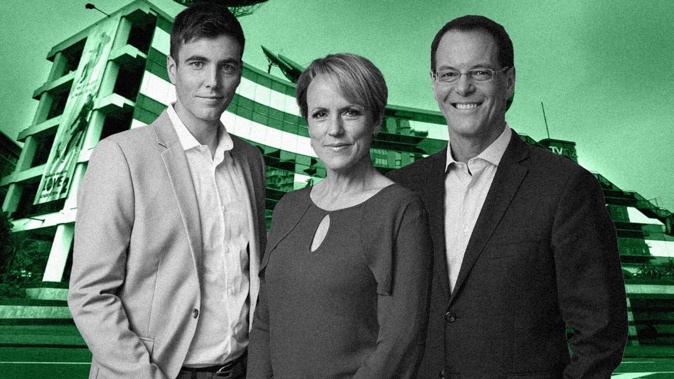

TVNZ is enjoying record digital audiences, offering hope and a clear direction for the future as it posts a big financial loss in a tough economy.
TVNZ has posted an after-tax loss of $85 million - including a non-cash impairment of $62.1m - with more cost-cutting set to impact the state broadcaster as it reshapes itself for a digital-first future.
The broadcaster announced today an EBIT (operational earnings) loss of $28.5m for its financial year ended June 30 - in line with its earlier market disclosure of an expected $28m-$33m loss.
It expects a similar loss this financial year, although it is working with staff on ideas to either raise revenue and/or cut more costs to close this $30m gap.
After a small net profit of $1.7m in 2022/23, TVNZ has been harshly hit by poor economic conditions over the past 12 months, with a big drop in advertising revenue.
Its overall revenue dropped almost 12% to $288.9 million, from $327.6m the previous year. Advertising revenue was $272.7m, compared with $309m in the previous 12 months.
The company said it had achieved $9.9m in annualised savings from its well-publicised programming (Sunday, Fair Go) and staff cuts and other cost reductions. There was a net reduction in TVNZ’s cash reserves of $7.4m.
The non-cash impairment reflected a re-evaluation of the company’s assets across the board, said O’Donnell, including its building in central Auckland.
TVNZ is a state-owned enterprise that does not receive taxpayer funding. However, its financial situation means it won’t be paying a dividend to its shareholder - the public - once again this year.
 TVNZ chief executive Jodi O'Donnell.
TVNZ chief executive Jodi O'Donnell.
Financial outlook
TVNZ chief executive Jodi O’Donnell described conditions as “extremely challenging” for advertising-funded broadcasters globally.
As well as announcing TVNZ’s financial year results, O’Donnell also gave a 2025 financial year outlook, which gave a glimmer of hope.
The market decline was moderating in this current quarter, she said.
“We are cautiously planning for a stabilising of the economy and expect challenging market conditions to continue until the end of the calendar year,” said O’Donnell.
“We continue to be disciplined on our cost outlook and are working with our people to find solutions to a $30m challenge in FY25. We need to stabilise losses quickly and continue with a multi-year programme to strengthen our streaming technology.
“We have a clear commercial mandate, and will deliver on this and innovate at pace to be a more sustainable media business.”
O’Donnell confirmed the company was considering all options to diversify its revenue, so it did not have as big a reliance on the advertising market.
This included the possibility of entering the subscription television market. While there were no immediate plans, all options would be considered in the next five years, as TVNZ developed its digital-first plans.
She said the company had proven its ability to deliver “must-watch” content.
“Now our focus is on maximising new ways to monetise our content so we’re in a strong position to take advantage when the market stabilises.”
 TVNZ's Jack Tame. Photo / TVNZ
TVNZ's Jack Tame. Photo / TVNZ
Digital strategy on track
O’Donnell remained confident the broadcaster’s digital-first strategic plans were on track.
TVNZ+ achieved 25% year-on-year viewership growth, recording 464 million streams for the period. Weekly audience reach had increased 16%.
Digital advertising revenue also grew (up 8.2%), “providing a clear commercial path for the company”.
“TVNZ successfully executed on its strategy to deliver compelling content that drove growth in audience reach in FY24,” said O’Donnell.
“TVNZ was the highest-reaching content provider across TV and TVNZ+, ahead of YouTube and Netflix, and 1News was surveyed as the most popular and trusted source of news.
“Despite this, and our careful management of costs, our financial performance reflects a constrained economy, market disruption and a difficult advertising market. It has been an extremely challenging period for ad-funded broadcasters globally, including TVNZ, but we are confident in our turnaround plan and digital strategy.”
She said TVNZ had sufficient cash to fund its digital strategy over the next three years.
The broadcaster was once again, not in a position to pay a dividend to its “shareholder” - ie, the public - in light of the loss.
“The company is in a position to address its multi-year tech debt, build a robust and scalable IP platform to support its digital progress, and return to profit.”
News and sport content
O’Donnell said TVNZ was transforming the presentation of news and current affairs to digital audiences, including more prominent news content on TVNZ+.
“We’re seeing good growth in our digital news, with a 16% increase in weekly news viewership on TVNZ+ in FY24.”
Sport was now a cornerstone of TVNZ’s content offering, she said.
“On TVNZ+, cricket, Black Clash and Super Bowl, and other key sporting events drove significant streaming audiences and new sign-ups. In June 2023, TVNZ+ launched a dedicated home for sport, and in its first 12 months, sport content was viewed by almost 910,000 accounts, with close to 15.4 million streams.”
Editor-at-Large Shayne Currie is one of New Zealand’s most experienced senior journalists and media leaders. He has held executive and senior editorial roles at NZME including Managing Editor, NZ Herald Editor and Herald on Sunday Editor and has a small shareholding in NZME.
Take your Radio, Podcasts and Music with you









